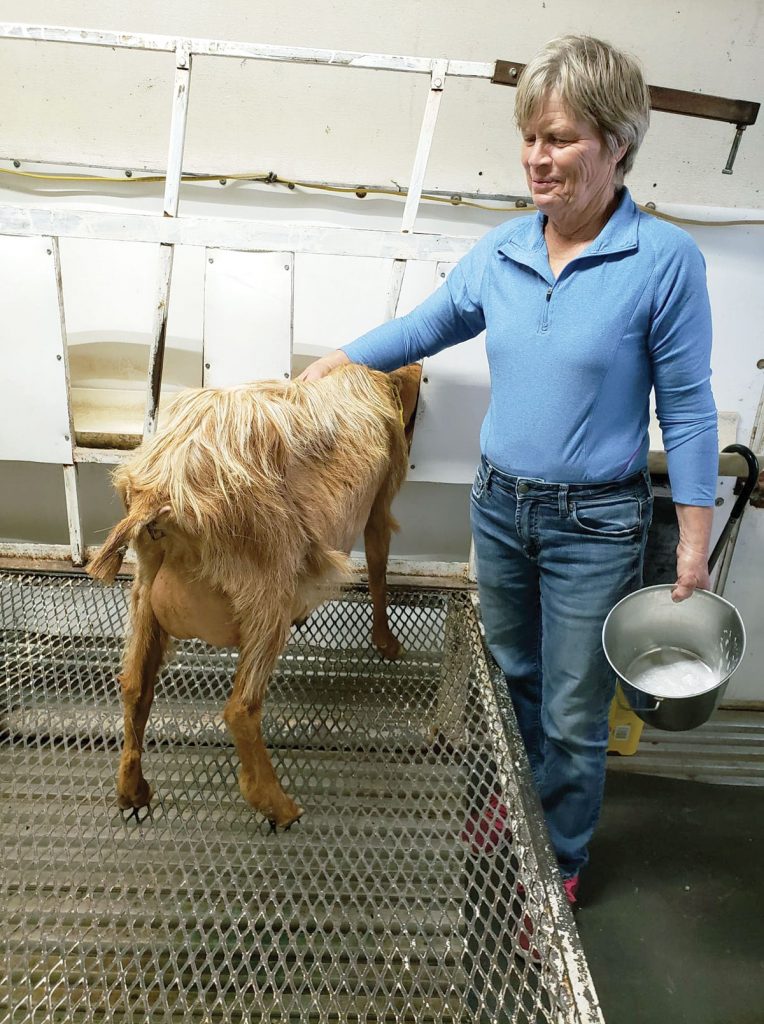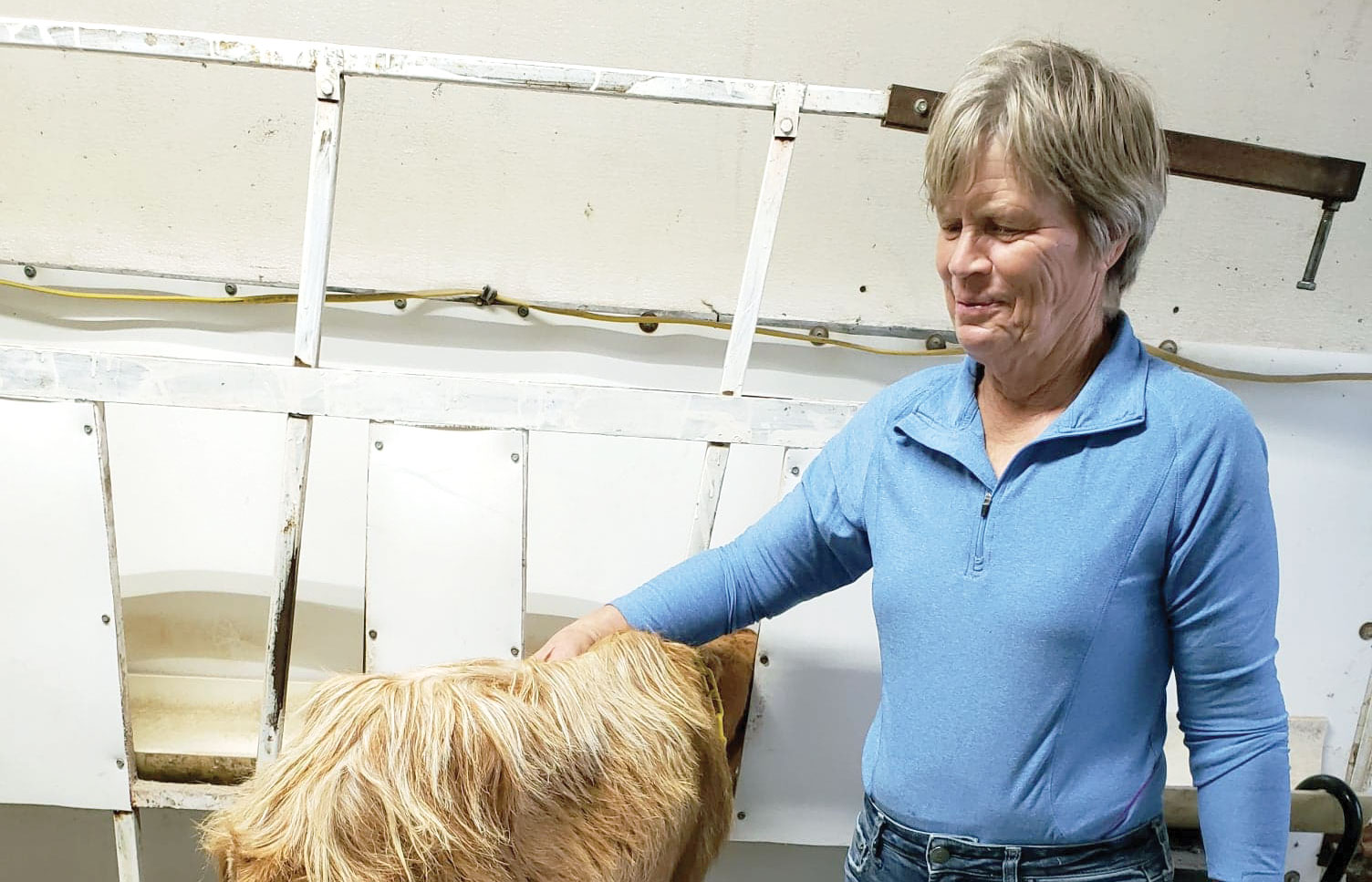
Darla Grumbein specializes in the heritage breed and it’s rich milk
Rick and Darla Grumbein met during their middle years when a friend introduced them to each other because we were both in the livestock industry.
At the time, Rick was rodeoing and raising bucking bulls that he sold all over the country while Darla was working at what was the 10,000-acre Kelly Ranch, a large stocker operation with significant herds of goats and sheep.
Darla grew up in Southern California in Orange County where she was exposed to a exemplary FFA program. Part of that program was a facility that held 100 steers and 80 sheep. After graduating from high school, Darla then went to an agricultural college further north and made her living on the back of a horse, mostly working with cattle. When a friend asked Darla to come for a visit to Oklahoma 23 years ago, Darla was immediately drawn to the land and people and moved there.
Darla bought three milk goats she kept at Rick’s. Like many cattlemen, he thought the purchase odd. Darla had back issues, so working with cattle was much less feasible than working with small ruminants like her dairy goats. Then Rick as injured in an accident at a cattle sale that resulted in a traumatic brain injury, their life changed dramatically.
“Rick (who has no memory before the accident and had to learn how to walk and talk again) had rehab eight hours a day in Tulsa,” Darla explained. “We got into a routine where I first hand milked two goats as he watched before driving him to Tulsa for rehab five days a week. When we arrived, I would drop him off and wait to take him back home. I spent the time exploring Tulsa, reading and even working out in a gym.”
He got better and no longer thought of the goats as odd. He soon began to enjoy petting them. Before long every baby was his and not something to sell. Because small ruminants are both safer and easier to raise than cattle, what had been home to bucking bulls became home to dairy goats and sheep.
Goats often have twins or triplets so Darla soon had a herd of 40 purebred La Manchas and a few Golden Guernseys, a heritage dairy goat breed from Guernsey Island known for high butterfat content just as Guernsey cattle are. In fact, Golden Guernsey milk has up to 9 percent butterfat. Like the Lipizzaner horses, a small group was saved from German extinction during World War II by being hidden away though it was listed as endangered in 2007 and as a minority breed in 2020.
Because the gene pool for the Guernsey breed is so small, Darla AIs her goats to maintain as much genetic diversity as possible. She also tries to do semen exchanges for the same reason. A slight adjustment may soon be made because a veterinary clinic in Blue Jacket recently added a veterinarian who specializes in AI.
Darla found an outlet for her goat milk when she discovered some customers who purchased goats from her also had a Grade A goat dairy. Darla then changed her operation to Grade A. When that dairy went under, she found another creamery in Arkansas built in the 1940s that used old equipment. When equipment wore out, the creamery had to find other old, used equipment rather than the new computerized equipment so everything was compatible. That creamery had 25 goat producers, with Darla being the only one non-Amish producer. After four years, the Arkansas plant went out of business.
Because of the closure, Darla sold most of her LaManchas, but expanded her Guernsey herd. Now Darla has 35 breeding females, 20 of which she is currently milking by hand.
“I love milking by hand,” Darla said. It is more personal, peaceful and a pleasure more than a job.”
The daily milk output of 20 goats is approximately equal to one Holstein cow. She sells raw milk with most of it going for human infants who cannot tolerate formula since goat milk is easier to digest.
Darla also raises commercial sheep with a herd of 95 ewes naturally bred by two rams. Her first sheep came from Kelly Ranch. Like goats, sheep are highly prolific with a very high percentage of twins and triplets. In this year’s production, 80 percent of the births were twins with nine sets of triplets adding to the crop.
Some ram lambs are sold to the Hispanic and Muslim communities. That customer base altered her breeding schedule so lambs are born in February rather than in the spring in order to be ready for important ethnic religious holidays. Some ewe lambs not used for replacements are also sold by private treaty, with the rest of the lamb crop going to auction.
Darla sells her ram lambs privately. Because of religious criteria, the lambs are not castrated. Customers take the ram lambs to be ritually slaughtered by a priest. The ethnic and religiously centered customer base provides a steadier market than the cattle market so financial management is easier. The rest of Darla’s lamb crop is typically sold at auction in Leach, Okla., a with most of the lamp crop being consumed rather than purchased for finishing.
“Purebred goats pay for themselves while sheep are the moneymakers,” Darla said. “They are highly-efficient creatures needing little hands-on care if raised under intensive rotational grazing.”
Darla has 100 acres and combines the sheep and goats into one herd using portable electric fencing to create small padlocks. A complete pasture rotation is a minimum of three weeks, though six is best to break the parasite cycle. Unlike goats, which are browsers, sheep prefer broadleaf vegetation. In order to meet the nutritional needs of both species, detailed pasture management is essential. Darla hays 16 acres and pastures the rest using no fertilizer and no herbicide. According to Darla, her pasture acreage would support 30 cows with supplemental hay in the winter. Darla still has to mow because her combined herds are insufficient to keep the pastures from becoming overgrown. Darla’s hayfield is never grazed and is 50 percent clover with added lespedeza for the goats with her hay testing close to 16 percent protein.
Maintaining nutrition for both ruminants requires a variety of vegetation, including grazing turnips; the leaves are almost 20 percent protein. Cold grazer rye snow peas must be no-till drilled. Grazer vegetation and peas are planted in the hayfield in the fall so by mid-April the vegetation is shoulder height. Darla also uses a hybrid cereal rye.
One of the most influential people in Darla’s life was Wally Olson, her boss at Kelly Ranch. He was an easy going, almost eccentric individual who used a day planner. He would think about five things at a time, keep them all straight, and on top of everything else knew how to make money. Sometimes when Darla would ask him a question, she come back the next day only to find out he had signed her up for class, including 12 grazing classes. He was also willing to experiment to find what was best and experimented with both rotational timing and herd health.
What she remembers most, however, is his handling daily problems by asking, “Is it going to matter in 10 years?”







